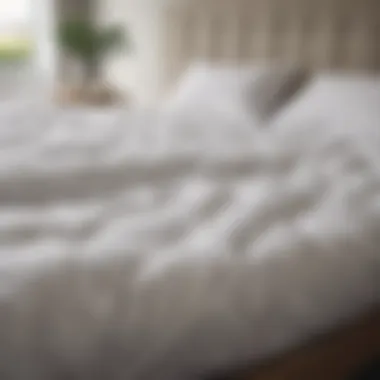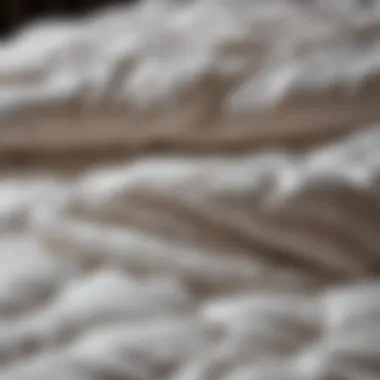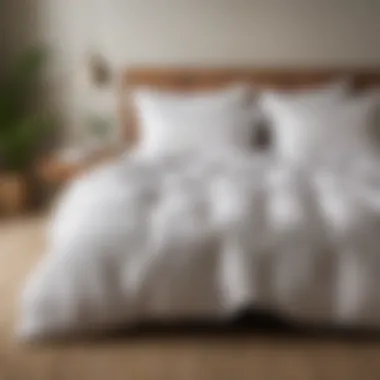Discovering the Best Duvets for Warm Weather Comfort


Intro
Choosing the right duvet for warm weather can make the difference between a restful night and a frustrating one. As the temperature rises, many people find themselves tossing and turning under heavy bedding that doesn't allow for adequate breathability. So, how do you know which duvet to pick for those balmy nights? In this guide, we will unpack all the necessary details to help you make an informed decision that suits your comfort needs and elevates your sleep experience.
From understanding various materials like cotton and linen to evaluating their thermal properties, we’ll cover the basics and beyond. You'll gain insights into sustainable options for those keen on reducing their carbon footprint without sacrificing coziness. This guide aims to navigate the intricate world of bedding, focusing on summer-specific duvets and comparisons for different budgets and preferences.
If you’re tired of night sweats or waking up feeling like you’re in a sauna, stay with us. Let’s take a closer look at the key factors that define the best warm weather duvets.
Understanding Duvets and Their Functionality
When one considers bedding, it’s easy to overlook the subtle but critical role duvets play in achieving a good night's sleep. Understanding how duvets function not only illuminates their purpose but also highlights why choosing the right type is essential—particularly in warmer climates. In essence, a duvet serves as a lightweight cover that provides adequate warmth without the heaviness or bulk typically associated with blankets. This quality makes them especially relevant as the temperature begins to rise.
Choosing the right duvet can significantly enhance one’s sleep experience. A suitable duvet fosters better sleep through temperature regulation and comfort, which ties directly into an individual’s overall health and well-being. After all, no one wants to toss and turn all night, waking up in a sweat or feeling constricted by their bedding. This makes understanding the functionality of duvets crucial for any homeowner or renter.
Furthermore, getting a grasp on how duvets operate can help you appreciate their versatility. Unlike blankets, which are often designed for specific weather conditions, a duvet can be tailored to fit varying climates and personal preferences. Being informed about this aspect means you can make smarter choices—whether you're seeking a cozy layer during chilly nights or a light cover for those balmy summer evenings.
Definition and Purpose of a Duvet
A duvet is essentially a soft flat bag filled with bedding material, typically with a cover that is washable. The primary purpose of a duvet is to provide warmth without the added weight, which is particularly beneficial for warmer weather. Traditionally filled with down or feather, many modern duvets use synthetic materials that mimic the properties of down while offering easier maintenance.
Apart from warmth, a duvet's design also allows for various aesthetic choices. They come in many colors and types of fabrics, giving homeowners the opportunity to match their duvet to their decor while not sacrificing functionality. Whether it's a cotton duvet for breathability or a silk one for a luxurious feel, the options are plentiful.
How Duvets Differ from Comforters
While both duvets and comforters serve similar basic functions—providing warmth—they have distinct differences that are important to consider. Understanding these differences opens the door to making a more informed decision about what will serve your needs best.
- Construction: Duvets are typically encased in a removable cover, while comforters are usually stitched together, making them a single, non-removable piece.
- Adjustability: With a duvet, you can easily switch out the cover to refresh the look of your bedding without buying a whole new set. Comforters don’t offer this luxury; you’re stuck with the design and fabric you choose.
- Care Requirements: Duvets often come with machine-washable covers, making them simpler to maintain, while comforters may require special care when washing, especially if they are thick or filled with materials like down.
Key Features of Warm Weather Duvets
When it comes to selecting a duvet suitable for balmy nights, understanding the key features is essential. A warm weather duvet is not simply a lighter version of its winter counterpart; it offers unique attributes that cater to the demands of increased temperatures. These features focus on maintaining comfort while ensuring breathability, moisture management, and overall feel. Choosing the right duvet relies heavily on these considerations, as they play a significant role in the quality of sleep and the overall sleeping environment.
Breathability and Moisture Management
Breathability is perhaps the most critical feature to evaluate when it comes to warm weather duvets. A duvet that cannot absorb or wick away moisture tends to trap heat, causing discomfort and restlessness. Breathable materials promote airflow, allowing heat and moisture to escape, bringing about a more comfortable sleeping experience.
Moisture management is equally vital, especially in warmer climates or during the summer months. A duvet that excels in both these areas will help regulate body temperature, making it easier to stay cool throughout the night. Therefore, look for materials known for their moisture-wicking properties, such as cotton and linen.
Weight Considerations
Weight is another factor that deserves careful thought. A traditional duvet can be heavier, and this added weight may feel stifling in warm weather. A lighter duvet, on the other hand, will provide sufficient coverage without being overwhelming. When searching for a warm weather duvet, consider options that balance lightness with warmth; it’s not about how much weight it has but about achieving that perfect equilibrium for comfort during hotter seasons. Choosing a lightweight duvet ensures that your own body heat doesn't turn your sleep space into a sauna, which is what we're all trying to avoid!
Fill Types and Their Implications
The fill type of a duvet plays a huge role in shaping its performance, especially in warmer weather. Below we dive into three popular fill types and how they stack up in terms of comfort and practicality:
Down
Down fill is widely regarded for its luxury and comfort. It's made from the feathers found beneath the tougher exterior of birds, usually ducks or geese. This material holds in warmth without the weight, making it a popular pick. A key characteristic of down is its insulating ability, which provides warmth without bulk.
One unique feature of down is its ability to compress, allowing for easy storage during the off-season. However, it may not be ideal for everyone—those with allergies may experience discomfort, and it often requires specialized cleaning.


Synthetic Fill
Contrary to down, synthetic fill is made from man-made fibers that mimic the qualities of natural fill. This option is often more affordable and easier to care for, as it can generally be washed in a standard washing machine. An attractive characteristic of synthetic fill is its hypoallergenic properties, making it a sensible alternative for those who are sensitive to allergens.
However, while synthetic materials do provide decent insulation, they don’t always breathe as well as down, meaning they can retain heat and moisture if not designed with breathability in mind.
Bamboo Fiber
Bamboo fiber has emerged as a delightful choice for warm weather bedding. It's not just sustainable but also incredibly soft and breathable. The key trait of bamboo fiber is its natural moisture-wicking ability, which excels at keeping you cool and dry. It also has antibacterial properties, making it a fresh option for those hot evenings.
Nevertheless, while bamboo fiber is a superb material, it may come at a higher price point compared to more conventional options.
The right fill type can transform your hot summer nights from sweaty to serene; choose wisely!
Materials and Textiles for Warm Weather Duvets
Understanding the materials and textiles used in warm weather duvets is crucial for ensuring a comfortable night's sleep when temperatures rise. The right fabric can significantly influence breathability, moisture management, and overall comfort. Choosing the appropriate materials means you can enjoy the softness and feel of your duvet while also benefiting from the crucial thermal properties that help regulate body temperature.
When selecting a duvet for warmer climates, you must consider a few specific elements:
- Breathability: Effective airflow within the duvet fabric is essential to prevent overheating during warmer nights.
- Moisture Wicking: Fabrics that can wick away moisture contribute to a fresher sleeping environment, combating humidity issues that often accompany summer months.
- Durability and Care: The ease of washing and maintaining different fabrics matters as well, particularly for those sweaty summer nights.
With these factors in mind, let’s delve into the several textile options that come into play.
Natural Fibers: Cotton vs. Linen
Cotton and linen are two of the most popular natural fibers used in warm weather duvets. Both present distinct benefits tailored to varying preferences.
Cotton is often hailed for its softness and versatility. It’s widely accepted that cotton can be both breathable and absorbent, making it a top choice for hot summer nights. Many enjoy its hypoallergenic properties, as it’s less likely to irritate sensitive skin. However, keep in mind that higher thread counts can limit airflow, so opt for percale weaves if you want a more breathable feel.
Linen, on the other hand, possesses unique characteristics that contribute to its cooling properties. Made from the flax plant, linen fibers allow for substantial airflow and can absorb moisture without feeling damp. Many enthusiasts also appreciate linen's rustic texture and natural appearance. That said, it can wrinkle more easily than cotton, giving it a more relaxed look but requiring an occasional iron.
"Choosing between cotton and linen ultimately boils down to personal preferences—one prioritizes softness while the other embraces texture and breathability."
Synthetic Alternatives and Innovations
In today’s bedding market, synthetic materials play a major role, particularly for those seeking specific advantages. Innovations in textiles have led to the creation of moisture-wicking polyester and breathable blends designed for optimal comfort.
Microfiber is one such innovation. This fabric is lightweight and soft, providing a cooling effect that works well for warm nights. Additionally, microfiber has a tighter weave, keeping allergens and dust mites at bay. It is also wrinkle-resistant, which is a bonus for those who prefer low-maintenance bedding.
Another noteworthy material is Tencel, made from cellulose fibers derived from wood pulp. This fabric boasts moisture-wicking properties and is known for its silky smooth feel. It's eco-friendly too, appealing to those conscious about their environmental impact.
If your aim is to find a duvet that feels luxurious while keeping you cool, these synthetic alternatives can provide great comfort without sacrificing breathability.
Eco-Friendly Fabric Options
In an era where sustainability matters, many buyers are turning to eco-friendly fabric options for their warm weather duvet needs. Selecting sustainable materials not only contributes to a healthier sleeping environment but also promotes responsible consumption.
Organic cotton is a popular choice in this category. Grown without synthetic pesticides, it’s gentler on the environment and on your skin. This fabric still carries many advantages associated with cotton while ensuring that you're making an environmentally responsible choice.
Bamboo fabric has also gained traction for its unique properties. Naturally hypoallergenic and resistant to bacteria, bamboo can outperform traditional fabrics in moisture retention and breathability. Its production process is less water-intensive compared to cotton, making it an admirable sustainable choice.


Investing in eco-friendly materials lays the foundation for a restful sleep while showing respect for our planet. As consumers become more aware of their choices, the demand for these innovative textiles continues to rise.
Selecting the Right Warm Weather Duvet
When choosing the right duvet for warm weather, it's not just about picking the most attractive one on the shelf. The climate, your personal comfort, and even your lifestyle all play a significant role in making this decision. A suitable duvet can dramatically improve your sleep quality and overall well-being during those hot, sticky nights where tossing and turning feels like a rite of passage.
Assessing Personal Preferences
One person's cozy is another’s stifling heat. Every individual has unique preferences that guide their choice. For instance, some may crave the plush comfort of a down duvet, while others might prefer the lighter touch of synthetic materials.
To weave through this, consider the ambience of your bedroom. Do you like layering your bedding, or do you prefer a minimalist look? Think about how warm or cool you usually feel at night. Are you someone who gets hot easily, or do you find yourself constantly seeking more warmth? Knowing your sleeping habits is vital.
You may also want to reflect on any allergies. For those with known sensitivities, opting for hypoallergenic materials might be necessary. Being honest with your likes and dislikes in bedding is the first step in curating a duvet collection that enhances your comfort.
Budget Considerations
Money talks, as they say, and the world of duvets is no exception. With a broad range of prices that can make your head spin, it’s crucial to define a budget beforehand. Remember that investing in a higher-quality duvet might save you money in the long run, as cheaper options may degrade faster.
Factors influencing the price include:
- Material: Natural fibers like down and organic cotton often come at a premium compared to synthetic alternatives.
- Brand Reputation: Renowned brands may charge more, yet they often guarantee better craftsmanship.
- Durability: A well-constructed duvet is less likely to need replacement.
Evaluating these elements can help you land on an option that does not only fit your finances but also provides the comfort you're after.
Washing and Maintenance Requirements
When it comes to care, a duvet shouldn't feel like a burdensome task. The maintenance needs of a duvet can vary significantly. Some allow machine washing, while others will have you running to the dry cleaner faster than you can say "refresh." If you're one to procrastinate laundry, find a duvet that is easy-care and holds up through multiple washes.
Here are a few pointers:
- Check Labels: Manufacturer's instructions provide invaluable guidance on cleaning.
- Frequency: Consider how often you plan to wash your duvet. If it’s frequently used, ease of washing becomes all the more important.
- Storage: Even when not in use, proper storage is key. Make sure your duvet is stored in a breathable condition to avoid dampness and odors.
In summary, selecting the right warm-weather duvet involves understanding personal sleeping habits, budget limits, and maintenance requirements. Armed with this knowledge, you can choose a duvet that not only suits your style but enriches your sleep experience too.
Comparative Analysis of Top Warm Weather Duvets
Selecting the right duvet can feel like searching for a needle in a haystack, especially when warm weather calls for something that’s not only comfortable but also breathable. In a market flooded with options, a comparative analysis of top warm weather duvets becomes invaluable. This section helps you sift through the clutter, spotlighting features that matter—like fabric types and fill materials—with an emphasis on what different brands offer.
When we pit one brand against another, it's about more than just names. We look into how different duvets regulate temperature, how they hold up after multiple washes, and importantly, how their price tags compare to the comfort they provide. Understanding these elements can empower you to make a choice that enhances your sleep experience, turning your bed into a comfy sanctuary during those balmy nights.
Brand vs. Brand Y
To get started, let's examine Brand X and Brand Y. Brand X is often embraced for its lightweight design and excellent breathability. Many users rave about how it feels almost like sleeping under a cloud, letting air circulate effectively and resisting moisture build up. This duvet uses a high-quality cotton shell, renowned for its softness and durability.
On the flip side, Brand Y is known for its innovative use of synthetic fills. While it may lack the natural breathability of cotton, users point out its remarkable moisture-wicking capabilities. This can be particularly appealing to folks who tend to get quite warm during sleep. Moreover, if you’re someone who appreciates efficiency, Brand Y often dries quicker than cotton, making it a solid candidate for those spontaneous laundry days.
"Choosing between these brands depends largely on personal preference and sleeping habits. What works for one may not suit another."
While both brands have their merits, a key consideration remains: allergies. Those with sensitivities might find Brand Y’s synthetic options preferable, as natural fibers can sometimes harbor allergens. So here’s the takeaway: Zero in on what qualities matter most to you—whether it’s natural fabrics or synthetic prowess—and make an informed choice based on those reflections.
Price vs. Quality: Finding the Balance


Discussing price and quality is like trying to make a tasty stew; you need the right ingredients to get that perfect flavor. In the realm of warm weather duvets, it's all too common to find that bargain-priced options often skimp on something crucial—whether that be durability, warmth, or comfort.
Before you succumb to the allure of a low price tag, consider what you might be giving up. Higher price points, typically, offer better materials and construction. For instance, a higher-priced duvet may come with premium filling that resists clumping and lasts longer than cheaper alternatives.
That said, there are plenty of gems at moderate price points. It’s about finding balance:
- Price Point 1: Budget-friendly options, usually made from basic cotton or synthetic fills.
- Price Point 2: Mid-range picks that balance quality with affordability, often featuring cotton blends or more advanced synthetic materials.
- Price Point 3: Premium brands that justify the cost with superior craftsmanship and materials, aimed at those willing to invest in luxury.
Ultimately, the best approach is to evaluate what you prioritize in a duvet. To ensure you’re not just throwing money down the drain, ask yourself how often you’ll use it, the durability you expect, and the level of comfort you desire. After all, a good duvet should not only keep you comfy but also be a long-term investment in your sleep quality.
Sustainable Choices in Duvet Selection
In today’s world, the relevance of sustainability cannot be overstated. As climate change becomes an ever-pressing issue, making informed decisions regarding our home textiles, including duvets, is a vital step towards reducing our environmental footprint. This section focuses on sustainable choices in duvet selection, emphasizing the importance of choosing materials and brands that align with eco-friendly practices.
Choosing a sustainable duvet can lead to numerous benefits, not only for the planet but also for the consumer. These choices often involve materials that are kinder to the environment, enhanced ethical practices from suppliers, and better health outcomes for those using these products.
Sustainable duvets typically boast a longer lifespan and often require less frequent replacement, ultimately contributing to waste reduction. Moreover, they can offer the same level of comfort and quality as their conventional counterparts, thereby proving that luxury and environmental responsibility can coexist.
Identifying Sustainable Materials
When searching for a duvet that champions sustainability, it’s crucial to understand the materials involved. Here are some of the prime candidates:
- Organic Cotton: This material, grown without harmful pesticides and fertilizers, protects both the environment and the farmers who cultivate it. It’s soft, breathable, and a popular choice.
- Bamboo Fiber: Bamboo grows rapidly and requires minimal water, making it an environmentally friendly option. Duvets made from bamboo fibers tend to be hypoallergenic and breathable, providing comfort during warm weather.
- Tencel (Lyocell): Derived from sustainably sourced wood pulp, Tencel is produced in a closed-loop process that recycles water and solvents. It’s soft, breathable, and has excellent moisture-wicking properties.
- Recycled Materials: Fabrics made from recycled plastics (like PET) not only reduce waste but also make for lightweight, durable duvets.
While shopping, look for labels or certifications indicating that the materials are organic or recycled. This helps to ensure that you are making a responsible purchase.
Ethical Brands and Certifications
The brand behind the duvet is just as important as the material itself. Supporting ethical brands that prioritize sustainable practices and community welfare is pivotal. Here are a few indicators to consider when seeking ethical brands:
- Fair Trade Certification: Brands that are Fair Trade certified ensure fair wages and conditions for workers involved in the production process.
- OEKO-TEX Standard 100: This certification guarantees that textiles are tested for harmful substances and are therefore safe for human use. It’s an assurance that you’re purchasing a product that is not only sustainable but also safe.
- Global Organic Textile Standard (GOTS): This certification applies to organic fibers throughout the entire textile supply chain, covering both environmental and social criteria.
Smart consumers often engage in a bit of sleuthing, researching the brand’s values and practices. Brands like Coyuchi and Buffy have gained attention for their commitment to sustainability and social responsibility. It won't hurt to check reviews or forums on platforms like reddit.com to see what others think.
Crafting a sustainable bedding experience doesn’t have to be a daunting task. By identifying sustainable materials and choosing ethical brands, you can create a sleeping sanctuary that respects both your comfort and the environment. This eco-conscious approach not only benefits our lifestyles today but helps ensure a better world for future generations.
Frequently Asked Questions About Warm Weather Duvets
In any pursuit of comfort, asking the right questions can be half the battle. This section tackles common queries regarding warm weather duvets, giving readers clarity on their choices. Understanding these aspects not only aids in making informed decisions but also enhances the overall duvet experience. After all, a good night's sleep is hugely influenced by what you wrap around yourself.
What Should Look for in a Warm Weather Duvet?
When searching for the ideal warm weather duvet, a few specific features should be on your radar.
- Breathability: This is non-negotiable. Look for materials that allow air to circulate, helping to wick moisture away from the body. Fabrics like cotton or linen often fit the bill well.
- Weight: In warm weather, less is more. Opt for lighter duvets that won't weigh you down.
- Fill Type: While down fills can be luxurious, they tend to retain heat. Consider synthetic options or lighter natural fills that are specifically designed for summer use. Bamboo fiber is also a worthy contender, known for its temperature-regulating properties.
- Care Requirements: Duvets can accumulate dust and allergens. Therefore, it’s wise to choose one that is machine washable, ensuring it remains fresh and clean.
- Allergies: If you’re sensitive to allergens, synthetic fills or hypoallergenic options should be top of your list.
"When evaluating what to look for in a duvet, think about your comfort preferences and the conditions of your sleeping area. It’s not just about the duvet itself but how it interacts with your personal sleeping habits."
All these factors combine to create a comfortable sleeping environment that supports better rest through the warmer months.
How Do Care for My Duvet?
Caring for your duvet correctly ensures it remains fluffy and inviting for years to come. Here's how to stay on top of it:
- Check the Labels: Always start by reading the care instructions that come with your duvet. Different materials might require specific care.
- Regular Washing: Aim to wash your duvet about every six months, or more often if you're prone to allergies. For many duvets, water at a moderate temperature and a gentle cycle will work. Avoid fabric softeners, as they can impair breathability.
- Drying: Always dry your duvet thoroughly to prevent mold growth. Toss in some dryer balls or clean tennis balls to help fluff the duvet while it dries. Air drying in a shaded area can work wonders, too.
- Storage: Off-season, store your duvet in a breathable bag. Avoid plastic bags as they can trap moisture, creating a breeding ground for mildew.
- Spot Clean: For minor stains, spot clean as soon as possible. Use mild detergent and a damp cloth, and gently dab—never rub.
To maintain your duvet’s loft and warmth, follow these recommendations, and you'll enhance its lifespan while ensuring it stays suitable for warm weather sleeping.















